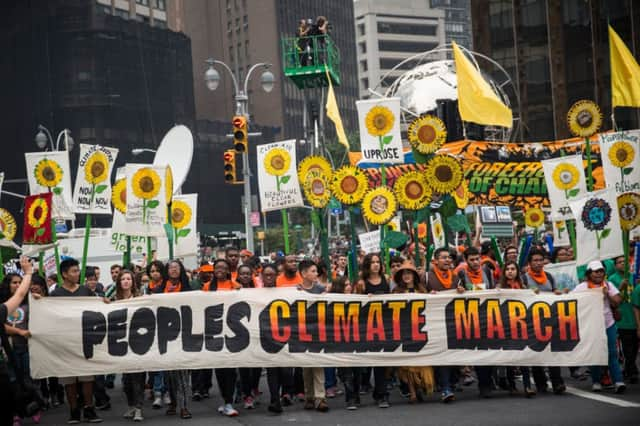Push climate game changer over the line


The intergovernmental Open Working Group on Sustainable Development Goals probably isn’t a familiar body to many people but its work could significantly change the way we live our lives.
It was tasked by the Rio+20 Conference in 2012 with devising a sustainable blueprint for our planet, with actions to reduce poverty, advance social equity and ensure environmental protection – the so called Sustainable Development Goals (or SDGs).
Advertisement
Hide AdAdvertisement
Hide AdIn September, while I joined thousands marching through New York to demand urgent action on climate change, the United Nations General Assembly adopted the group’s outcome document with 17SDGs and 169 targets. It was an important milestone in the journey towards a more sustainable future, where no one is left behind¨While in New York I met Csaba Körösi, Hungary’s UN ambassador and one of the figures seeking to chart a new course for sustainable development.
With ambassador Körösi, co-chair of the Open Working Group (OWG), I discussed their progress and the key challenges the group has faced, particularly on the divisive issue of whether to include a climate change-related goal, in parallel with the ongoing international climate change negotiations.
“The most interesting struggle throughout the process of crafting the SDGs was whether or not the member states would allow one of the SDGs to focus on climate change,” he told me. “Climate change is one of the game changers. Climate change is one of reasons why we need to change the development trajectory. It is one of the key factors why we must re-think our economy.”
Ambassador Körösi continued: “But climate change involves very sensitive negotiations, producing hopefully a legally binding outcome. Therefore some of the member states felt a little bit uneasy to pre-judge the outcome of the climate negotiations.
“On the one hand we were being cautioned to skip climate change – the view was ‘let’s keep it in mind but let’s not create an SDG that in any way pre-judges the outcome of the climate negotiations’.
“There was another group of member states who believed that we should speak very clearly of climate change, otherwise the SDGs might be considered irrelevant. At the beginning of the process, the second group was a very small minority. Most of the players were against the climate change goals, much more than 50%, and basically all the big countries.”
Reaching agreement on the precise number of SDGs has been equally complex.
Ambassador Körösi commented: “When we started the process we all believed we should agree a limited number of goals but most of us believed it would be fewer than 17. Any of us could think of a much smaller number of SDGs as an intellectual exercise. But the question is: can you have 193 countries agree on a smaller number in a different set? We tried several times, throughout the negotiations. Each and every attempt to merge, to integrate some of the big issues was blocked by one or another Member State.”
Advertisement
Hide AdAdvertisement
Hide AdSo, the SDGs – like every form of international agreement – are the result of an uneasy compromise. They nevertheless represent a moment in history, described by many as a “once-in-a-generation opportunity for transformational change”.
But reaching agreement on the SDGs is only part of the challenge – as ambassador Körösi tells me, there are further key challenges to resolve – communicating the goals and ensuring their implementation.
The ambassador is concerned that the SDGs, as they currently stand, do not pass the ‘M&M’ test – that is, they must be equally understood by ministers and by mothers. Ministers have bought into the process but “for the mothers there is still work to be done” he said. Convincing the public that the SDGs support their interests will be the real litmus test.
“We cannot motivate people and governments by threats; you need to turn them into opportunities of real economy, of real society and real life in community. This remains to be done. The aspirations are nice but they do not solve the challenges ahead of us’” said the ambassador.
In Scotland a Post-2015 working group has been established with key representatives of the sustainability and international development agendas, plus officials from the Scottish and UK governments. The purpose of this group is to share intelligence, to influence where possible the negotiations and prepare for the implementation of the Post-2015 Agenda.
The coming year will be decisive because the decisions reached in 2015 on both the sustainable development and climate change agendas will have an impact on generations to come.
Ambassador Körösi remains hopeful. He said: “Sustainable development in simple terms is a set of bridges between past, present and future; humans and nature; between politics and economics; rich and poor and north and south. The SDGs represent the construction of the bridges.”
Right now there is a need to give a big push to complete the crafting of inspirational, aspirational and implementable sustainable goals. It must be a vision simple enough to captivate the imagination and engage the action of governments, civic society and the wider public.
Advertisement
Hide AdAdvertisement
Hide Ad• May East is CEO of CIFAL Scotland, a United Nations Institute for Training and Research sustainability centre based in Edinburgh
SEE ALSO